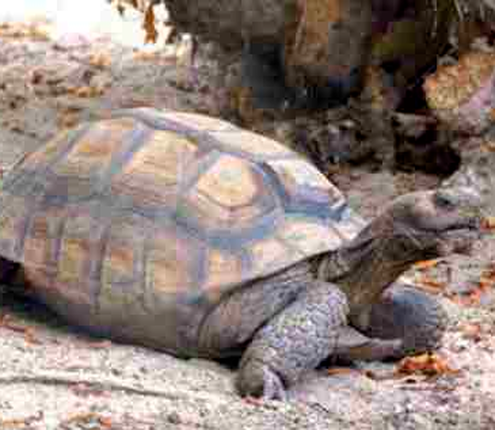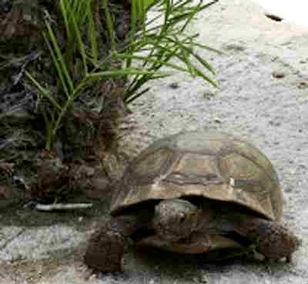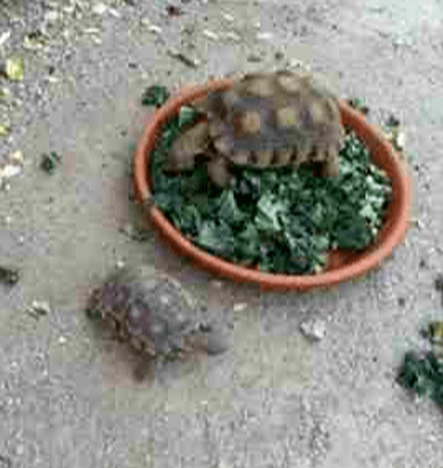Our Mission at The Desert Tortoise Conservancy (TDTC)
The mission of The Desert Tortoise Conservancy is to insure that the species does not become extinct, and that sustainable populations survive in the wild. Our goal is to preserve, protect and perpetuate the desert tortoise. We will accomplish this by increasing public awareness of the plight of the tortoise, educating the public on the role humans have played and continue to play in the tortoise's decline, and work to modify those human behaviors such that tortoise populations stabilize and ultimately recover.
TDTC is focused on the Mojave desert tortoise (Gopherus agassizii), whose populations have declined in some areas by as much as 90%, and whose population is listed as threatened. |
Our Strategy
North American desert tortoises have seen their natural populations decimated by development, habitat destruction and fragmentation, and other human-caused threats including chemical and hormonal pollution, gradual global warming, invasive alien species, various illnesses due to introduced pathogens, such as the upper respiratory tract disease and a number of other human caused factors. Conservation International’s President, Russell Mittermeier says: “Turtles have been around since before many dinosaurs walked the planet and have survived relatively unchanged for about 250 million years, but mankind’s actions have brought them to the brink of extinction. It’s our responsibility to bring them back.”
TDTC intends to build an architecturally significant tortoise awareness center which will attract the pubic in large numbers. The center will be located in the Palm Springs, California area, which already hosts millions of tourists annually. The center will contain: educational exhibits and displays, a theater airing educational films, a children's "petting" area where a naturalist will help children hold and learn about pet and wild tortoises, and a display looking into tortoise burrows so tortoises may be observed 365 days each year, even when brumating. The center will also have one or several trails where naturalists can point out tortoises, when out, borrows, and vegetation. Finally, it will contain a retail space where items may be purchased and donations made. Visitors will leave the facility with a new appreciation of the importance of protecting these animals, and how each of us can make a difference.
Visitors will learn that:
TDTC intends to build an architecturally significant tortoise awareness center which will attract the pubic in large numbers. The center will be located in the Palm Springs, California area, which already hosts millions of tourists annually. The center will contain: educational exhibits and displays, a theater airing educational films, a children's "petting" area where a naturalist will help children hold and learn about pet and wild tortoises, and a display looking into tortoise burrows so tortoises may be observed 365 days each year, even when brumating. The center will also have one or several trails where naturalists can point out tortoises, when out, borrows, and vegetation. Finally, it will contain a retail space where items may be purchased and donations made. Visitors will leave the facility with a new appreciation of the importance of protecting these animals, and how each of us can make a difference.
Visitors will learn that:
- They should always cover garbage cans, in raven-proof containers, and to never litter.
- That off-roaders must be required to stay on established paths/roads.
- Not to poach wild tortoises.
- Not to pick up or disturb tortoises in the wild. A tortoise often voids a year's worth of stored water when disturbed, and then dies of dehydration.
- Not to return/place pets in the wild.
- Not to breed tortoises
- Not to let dogs run loose
BackgroundThe desert tortoise is one of four tortoise species found in North America. It can be found in four states – California, Nevada, Arizona and Utah. Desert tortoises reach 8 to 15 inches in length and 4 to 6 inches in shell height. Adult tortoises can weigh between 8 and 15 pounds. A desert tortoise’s lifespan is 60 to 80 years in the wild, 80 to 100 years in captivity. The first 5 years of their life are the hardest as their shells are still not completely hardened, making them more susceptible to predators. The desert tortoise does not become sexually mature until 13 to 20 years of age. Females lay one to ten eggs and zero to three clutches per year. Once tortoise reach maturity their rate of survival increases significantly.
|
Tortoises have become well adapted to their harsh desert environment, possessing nails for digging and strong forearms and elephant-like hind limbs. Since desert climate is so extreme, the desert tortoise spends a majority of its life underground in burrows they dig or find already made. A tortoise will have multiple burrows throughout their home range. The average male desert tortoise has a home range averaging 200 acres, with females averaging half that amount. In a lifetime a tortoise can use over 1.5 square acres and can travel as much as 7 miles at a time. In the winter, tortoises enter a state of “brumation”. Unlike hibernation, a tortoise in a state of brumation will leave its burrow if there is rainfall in the winter, but returns quickly. They emerge from their burrows in early spring and stay active until fall. During this time the tortoises will mate and depending on food and water availability will lay eggs.
Their habitat can range, but typically Mojave Desert tortoises are found below 5500 feet in creosote brush scrubs on gently sloping terrain. Desert tortoises are herbivores, feeding only on plant material. They eat a wide variety of grasses and annual flower plants. Tortoises are even able to eat dried plant material and still extract water from it. Tortoises have the ability to store water in their bodies for over one year, an adaptation well suited for the desert.
Recent research has proven genetic, physiological and behavioral differences between the Sonoran and Mojave population of desert tortoise leading to a split between the two species, the Mojave (Gopherus agassizii) and the Sonoran (Gopherus morafkai). While both populations struggle to survive, the Mojave population is recognized as threatened by the United States Fish and Wildlife.
Their habitat can range, but typically Mojave Desert tortoises are found below 5500 feet in creosote brush scrubs on gently sloping terrain. Desert tortoises are herbivores, feeding only on plant material. They eat a wide variety of grasses and annual flower plants. Tortoises are even able to eat dried plant material and still extract water from it. Tortoises have the ability to store water in their bodies for over one year, an adaptation well suited for the desert.
Recent research has proven genetic, physiological and behavioral differences between the Sonoran and Mojave population of desert tortoise leading to a split between the two species, the Mojave (Gopherus agassizii) and the Sonoran (Gopherus morafkai). While both populations struggle to survive, the Mojave population is recognized as threatened by the United States Fish and Wildlife.
Threats to the Desert Tortoise
The desert tortoise faces a number of threats in the wild. The first is the present or threatened destruction, modification or curtailment of the desert tortoise habitat by urbanization, fragmentation and degradation. These things can happen by construction of roads and highways, Off-Highway Vehicle activity, poor grazing management, invasion of non-native species leading to increased wildfires, landfill and other waste disposal facilities and military operations. Over utilization for commercial, recreational, scientific and educational use including the deliberate maiming or killing of tortoises, collection for food or pets and for use in research is another threat to the tortoise. There are also factors of disease and predation. Upper respiratory tract disease is the number one disease killing desert tortoises. Ravens are the top predator of adult tortoises. Other predators include: red-tail hawks, golden eagles, loggerhead shrikes, American kestrels, burrowing owls, greater roadrunners, kit foxes, mountain lions, ground squirrels, free-roaming dogs and fire ants. The lack of funding to enforce regulations is an additional factor. Lastly, the unauthorized release or escape of pet desert tortoises into the wild poses a serious threat.
Recovery Updates
The Mojave population of the desert tortoises has been listed as threatened since April 2, 1990. In June of 1994, the first recovery plan for the Mojave desert tortoise was published. It contained a detailed strategy to recover the Mojave population which would hopefully produce positive outcomes by the year 2025. In 2003, the recovery plan was assessed by committee and it was noticed that while the 1994 recovery plan was adequate; revisions should be made with collaboration from scientists, managers and stakeholders. In June, 2011, a revised version of the recovery plan was released coming from this collaborative effort. In the near future, regional, inter-organizational Recovery Implementation Teams will be established to prioritize and coordinate the completion of the six major recovery actions:
- Develop, support, & build partnerships to facilitate recovery
- Protect existing populations and habitat, instituting habitat restoration when necessary
- Augment depleted population in a strategic manner
- Monitor progress towards recovery
- Conduct applied research and modeling in support of recovery efforts within a strategic framework.
- Implement a formal adaptive management program through which information gained while implementing the above strategic elements is used to revise and improve the recovery plan and recommend management actions on a regular basis
Conservation EffortsOne of the main goals of the recovery plan is to focus on conservation efforts. Those efforts include a variety of different ways in which the desert tortoise population can be recovered. Conservation strategies range from improved grazing to land acquisitions and habitat conservation plans to reducing raven populations. The desert tortoise is considered an umbrella species in the desert. It plays an important role in the balance of the desert, its burrows providing homes for other animals.
It is important for us to conserve what is left of the desert tortoise habitat that is intact and restore what we can for use by desert tortoises and other desert wildlife. In addition to securing lands and habitat for conservation it is also important for us to connect functional habitat. Since we know that tortoises are generally solitary animals that need large areas in which to feed, it is important to make sure they are provided with the space to be successful. |
The desert is being used for such a variety of activities – mining, grazing, landfills, and renewable energy. All of these activities have an adverse effect on desert tortoises and need to be minimized. The push towards renewable energy has resulted in the loss of thousands of acres of critical desert tortoise habitat. Solar and wind projects have already claimed approximately 60,000 acres with the potential of 11,000 acres in the near future. It is important for us to explore and begin to use renewable energy as well as use what the desert has to offer, but it should be done in moderation and should be monitored so that they are not impacting the well-being of the desert tortoise and other desert animals.
Excessive predation is a big factor in the decrease of desert tortoise populations. The main culprit is the raven (Corvus corvax). Ravens are intelligent animals and learn behaviors from their families. Because of this, it is extremely dangerous for hatchling desert tortoise when a community of ravens learns to prey on them. To combat this issue, it is the goal of the recovery plan to reduce the raven population by:
In addition to ravens, pet desert tortoises are also a danger to wild tortoises. Pet tortoises are exposed to different diseases than a wild desert tortoise. The most common of these diseases is upper respiratory tract infection. Untreated this infection can cause death. Upper respiratory tract infection is not always easy to detect and therefore a pet desert tortoise that can look healthy and is not showing any signs can still be carrying the disease. This is why it is important that pet tortoises of any age are not released into the wild.
It has been shown that an educated public is more likely to be aware of consequences and more willing to take responsibility for their actions. Therefore, the recovery plan calls for an establishment and continuation of environmental education programs. Southern California has its Desert Tortoise Information and Youth Education Program which is run from The Living Desert. The program focuses on desert users to try and change learned behavior and reduce conflict. It is also important to educate the future generations about the importance of preserving not only the desert tortoise, but also the desert, for one cannot survive without the other.
Source: Kyle Pong, Desert Tortoise Conservation Outreach Coordinator; The Living Desert
Excessive predation is a big factor in the decrease of desert tortoise populations. The main culprit is the raven (Corvus corvax). Ravens are intelligent animals and learn behaviors from their families. Because of this, it is extremely dangerous for hatchling desert tortoise when a community of ravens learns to prey on them. To combat this issue, it is the goal of the recovery plan to reduce the raven population by:
- Reducing trash availability to ravens at landfills
- Removing illegal dumps
- Adding fencing along highways to reduce road kills
- Removing or modifying nesting and roost sites so that they are not near nests and
- Identifying and removing ravens that have preyed upon or attempted to prey upon desert tortoises
In addition to ravens, pet desert tortoises are also a danger to wild tortoises. Pet tortoises are exposed to different diseases than a wild desert tortoise. The most common of these diseases is upper respiratory tract infection. Untreated this infection can cause death. Upper respiratory tract infection is not always easy to detect and therefore a pet desert tortoise that can look healthy and is not showing any signs can still be carrying the disease. This is why it is important that pet tortoises of any age are not released into the wild.
It has been shown that an educated public is more likely to be aware of consequences and more willing to take responsibility for their actions. Therefore, the recovery plan calls for an establishment and continuation of environmental education programs. Southern California has its Desert Tortoise Information and Youth Education Program which is run from The Living Desert. The program focuses on desert users to try and change learned behavior and reduce conflict. It is also important to educate the future generations about the importance of preserving not only the desert tortoise, but also the desert, for one cannot survive without the other.
Source: Kyle Pong, Desert Tortoise Conservation Outreach Coordinator; The Living Desert
Conclusion
The Desert Tortoise Conservancy, Inc. (TDTC) is committed to protecting, preserving and perpetuating the Mojave Desert Tortoise. Accomplishing our mission requires educating the public to the ways in which we humans are unwittingly destroying the tortoise, and to modify such behaviors. Specifically, these are the key behaviors contributing to the decline of the Mojave Desert Tortoise and how TDTC, through building and operating its Desert Tortoise Awareness Center and Experience intends to modify these behaviors and in so doing, to protect, preserve and perpetuate the tortoise.
Tortoise Populations are Rapidly Declining Due to:
- An explosion in the raven population. Raven population growth is directly linked to the growth of landfills, careless littering, and dumpsters being left open. Ravens use these sites as home bases from which to fly to areas where desert tortoise hatchlings are attacked and eaten. There is evidence, in fact, that some ravens are flipping over 15 pound adult desert tortoises and gutting them.
- Some off road vehicles in areas inhabited by tortoise destroy the tortoise both by directly running over them and by destroying their burrows, including burying them alive.
- The tortoises poached from the wild obviously decimate the remaining population.
- Picking up, handling or frightening tortoises often result in their deaths.
- Unwanted pet tortoises returned/released to the wild are extremely detrimental. First, these former 'captives' often carry diseases which they may have gained some immunity to. However, when they come upon a wild tortoise, they can easily communicate such disease, killing the wild tortoise. Second, tortoises are territorial, creating and inhabiting burrows, and occupying territory which can support them. When a new - formerly pet - tortoise is deposited in the wild - they will likely be unable to locate a burrow for themselves, or adequate water and food, before they perish. If they do locate a burrow, there may not be sufficient space, food, or water to support both the tortoise that was living there as well as the newly introduced tortoise.
- The development and continuing growth of major desert cities such as Las Vegas, Phoenix and Palm Springs, all previously occupied by large populations of Mojave Desert Tortoise, and the construction of roads, highways, wind and solar farms, mining and other development has severely impacted tortoise populations.
The Desert Tortoise Awareness Center and Experience Will Arrest this Decline by:
- The Center will promote a) not littering; b) signing on dumpsters to alert users to the importance of keeping lids closed; c) Keeping dumpster lids closed.
- The Center will promote responsible off-road vehicle use in areas inhabited by tortoise, suggesting off-road vehicle riders stick to established trails when riding in tortoise populated areas.
- Wild tortoises should never be poached. There are tortoises readily available for adoption as pets through the Turtle and Tortoise Clubs to qualified homes. Our center will assist interested families to adopt existing captive tortoises instead of poaching from the wild.
- A wild tortoise should never be disturbed. Such tortoises often void a year's worth of stored water when disturbed, and later die of dehydration. In addition, humans and our pet dogs and cats, as well as other pet turtles, carry numerous diseases which may inadvertently be passed to wild tortoises, which subsequently kill those animals.
- The Center will educate visitors to never release pet tortoises into the wild. Unwanted pet tortoises should be delivered to the Living Desert, Chapters of the California Tortoise and Turtle Clubs, or other sanctioned rescue facilities.
- We cannot expect to stop development and human population growth. However, a nearly 40 square mile preserve, the fenced and protected Desert Tortoise Research Natural Area (DTRNA) has been created and protected by the Desert Tortoise Preserve Committee (DTPC) for the past 39 years. The Center will recommend that every development on lands populated by tortoise be required to mitigate: that is - to acquire and contribute comparable amounts of land in or near the DTRNA, or provide a cash contribution equivalent to the DTPC or to our organization, such that tortoise lands removed for development are replaced by equivalent lands which expand on the existing DTRNA reserve, or others which might be established in the future.
|
This site is protected by reCAPTCHA and the Google Privacy Policy and Terms of Service apply. The Desert Tortoise Conservancy Phone: (503) 522-6611 Email: [email protected] |




